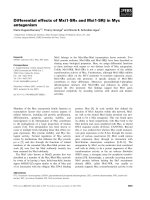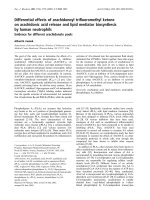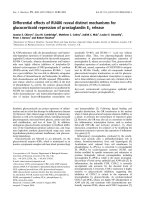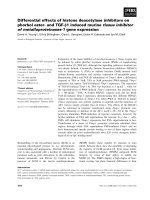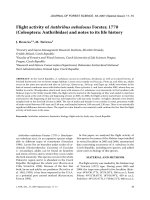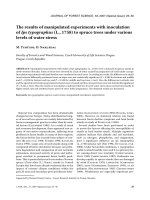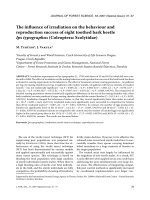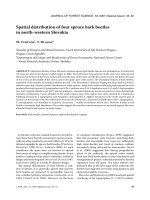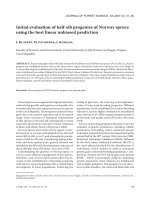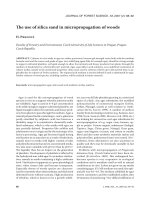Báo cáo lâm nghiệp: " Differential effects of N, P and K on photosynthesis and partitioning of N in Pinus pinaster needles" pptx
Bạn đang xem bản rút gọn của tài liệu. Xem và tải ngay bản đầy đủ của tài liệu tại đây (453.9 KB, 8 trang )
1
Ann. For. Sci. 62 (2005) 1–8
© INRA, EDP Sciences, 2005
DOI: 10.1051/forest:2004088
Original article
Differential effects of N, P and K on photosynthesis
and partitioning of N in Pinus pinaster needles
Charles R. WARREN
a,b
*, John F. MCGRATH
c
, Mark A. ADAMS
a,b
a
Department of Botany, University of Western Australia, Crawley WA 6009, Australia
b
Forest Science Centre, The University of Melbourne/Natural Resources and Environment, Water St, Creswick VIC 3363, Australia
c
Department of Conservation and Land Management, 17 Dick Perry Avenue, Kensington WA 6152, Australia
(Received 10 June 2003; accepted 3 October 2003)
Abstract – We investigated the response of one-year-old Pinus pinaster Ait. growing on a sandy, nutrient-poor soil to the factorial addition of
N, P and K. We tested two hypotheses: (1) fertiliser application increases rates of light-saturated photosynthesis (A
max
) and leaf-level water-
use efficiency (WUE, as indicated by carbon isotope composition), and (2) greater concentrations of N and Rubisco explain fertiliser-promoted
increases in A
max
and WUE. Two years after fertiliser application, the height of P. pinaster was significantly greater in plots to which P was
added (127 ± 7 cm; mean ± SE of three replicate plots) compared to those without added P (70 ± 10 cm), but was unaffected by addition of N
or K. The fraction of N present as Rubisco varied between 4 and 18% and was unrelated to N concentrations, but positively related to P and K
concentrations. A
max
and δ
13
C did not vary significantly among treatments and were unrelated to concentrations of Rubisco, N, P or K. We
conclude that fertiliser application two years previously has little effect on current A
max
and δ
13
C of P. pinaster, and thus the previously reported
effects of fertiliser on gas exchange are likely ephemeral.
nitrogen / phosphorus / potassium / photosynthesis / rubisco
Résumé – Effets différentiels de N, P et K sur la photosynthèse et le fractionnement de N dans les aiguilles de Pinus pinaster. La réponse
de plant de Pinus pinaster Ait., poussant sur un sol sableux et pauvre, a été étudiée en fonction de l’addition de N, P et K. Deux hypothèses ont
été testées : (1) la fertilisation accroît le taux de saturation lumineuse de la photosynthèse (A
max
) et le niveau d’efficience de l’eau (WUE, évalué
par la composition isotropique du carbone), (2) une plus grande concentration de N et de rubisco explique que la fertilisation accroît A
max
et
WUE. Deux années après l’application de la fertilisation, la hauteur de P. pinaster était significativement plus grande dans les placeaux où P
avait été ajouté (127 ± 7 cm, moyenne ± SE de 3 répétitions), comparativement à ceux sans addition de P (70 ± 10 cm) mais n’était pas affectée
par l’addition de N et K. La fraction de N présente sous la forme de rubisco variait entre 4 et 18 % et n’était pas expliquée par les concentrations
en N, mais était positivement expliqué par les concentrations en P et K. A
max
et δ
13
ne variaient pas significativement avec le traitement et
n’était pas reliés aux concentrations en rubisco, N, P ou K. On conclue que l’application d’un fertilisant deux ans auparavant a peu d’effet sur
les valeurs actuelles de A
max
et δ
13
C de P. pinaster et alors les effets rapportés auparavant des fertilisants sur les échanges gazeux sont
probablement éphémères.
azote / phosphore / potassium / photosynthèse / rubisco
Abbreviations: A
max
, maximum rate of light-saturated photosynthesis at ambient CO
2
; CE, capillary electrophoresis; C
i
, intercellular CO
2
concentration; Chl, chlorophyll; g
s
, stomatal conductance; LAI, leaf area index; PPFD, photosynthetic photon flux density; Rubisco, ribulose-
1,5-bisphosphate carboxylase/oxygenase; WUE, water-use efficiency; δ
13
C, stable carbon isotope composition.
1. INTRODUCTION
Application of fertiliser often increases the growth of Pinus
pinaster Ait. and other conifers [24, 38]. The mass and area of
foliage increases following fertiliser application, and this par-
tially explains the growth response [9, 46]. Fertiliser applica-
tion also increases rates of photosynthesis in some cases [9, 47,
48], but not all [10, 51]. Water-use efficiency (WUE) can be
increased by fertiliser addition [18, 21, 47] and on water-lim-
ited sites may be a further explanation of the growth response.
However, there are too few studies to unequivocally identify
either increased rates of photosynthesis and/or greater WUE as
primary causes of the growth response to fertiliser application
for field-grown conifers.
Studies on plant nutrition often focus on nitrogen (N) since
it is the nutrient required in the largest quantity and is generally
the nutrient most likely to limit carbon gain [14]. Among spe-
cies there is often a strong positive correlation between maxi-
mum rates of photosynthesis (A
max
) and N [16, 19, 56]. This
relationship owes much to the large proportion of N (up to 75%)
* Corresponding author:
2 C.R. Warren et al.
present in the chloroplasts, much of it in thylakoid membranes
and soluble proteins of the Calvin cycle, particularly the
enzyme Rubisco (ribulose-1,5-bisphosphate carboxylase/oxy-
genase; EC 4.1.1.39) [16]. Within conifers, N and photosyn-
thesis are positively reported for some species [35, 39]. More
generally, however, relationships between N and photosynthe-
sis are less consistent for conifers than for non-conifers, and
may be weak or even negative [33, 34, 41, 43, 45, 47, 52, 53].
Strong relationships between phosphorus (P) and A
max
have
been observed for conifers, for example in Pinus radiata [15,
47], P. pinaster [6, 30] and Pinus strobus [43]. A partial expla-
nation may lie in a positive relationship between the concen-
tration of P and amount of Rubisco, as observed in P. pinaster
[55] and in herbaceous species [11, 23, 26, 42]. In Picea sitch-
ensis, Rubisco activity per unit leaf mass was increased by
P addition [13]. Similarly, positive relationships between max-
imum rates of carboxylation (V
cmax
) and P were reported for
P. pinaster [30] and Pinus taeda [28].
Concentrations of other nutrients, such as potassium (K),
may also be related to A
max
[4, 5, 22]. Growth is expected to
improve in response to added K on some, especially sandy, soils
owing to the high mobility of K in both soil and plant and gen-
erally large plant requirements. K is the most abundant univa-
lent cation in plant cells and plays a significant part in regulat-
ing stomatal function [32]. Hence, one means by which K
deficiency reduces photosynthesis is by decreasing stomatal
conductance [40, 50]. More generally, transpiration increases
(and WUE decreases) if K is in poor supply [7, 29]. In these
cases, changes in stomatal conductance are not responsible for
the decline in photosynthesis; instead the large K requirement
for protein synthesis [27] is probably responsible for strong cor-
relations between concentrations of K and proteins such as
Rubisco [20].
It is possible that the responses of conifer growth to N, P and
K fertiliser share a mechanistic basis in their effects on photo-
synthesis and Rubisco concentration. Most studies relating N,
P and K nutrition to photosynthesis and Rubisco have focussed
on a handful of well-studied herbaceous species. Of the few
studies on conifers, none have included direct quantification of
Rubisco. Previously we reported relationships among addition
of P fertiliser, growth, and photosynthesis of P. pinaster [55].
Here we extend those observations using a factorial N, P, K fer-
tiliser trial at the same site and with one-year-old P. pinaster.
We measured the concentration of Rubisco and other major N
fractions in seeking to confirm the putative common basis for
relationships between N, P, K, A
max
and WUE (as estimated
by stable carbon isotope composition [17]).
2. MATERIALS AND METHODS
2.1. Field site
The field study was conducted in south-west Western Australia,
approximately 20 km north of Bullsbrook (latitude 31° 67’ S, longitude
116° 02’ E, 40 m above sea level) at a site we have described previously
[55]. The region has a Mediterranean climate with cool, wet winters
and hot, dry summers, in July (mid-winter), the mean daily tempera-
ture is 8.7 ºC and the maximum is 17.6 ºC. In January (mid-summer),
the mean daily minimum temperature is 17.0 ºC and the maximum is
33.1 ºC. Mean annual rainfall at Bullsbrook is 692 mm, with 84% of
the total annual rainfall between May and October. Potential annual
evaporation [8, 36, 44] is around 1700 mm. The soil at the site is a P-
deficient yellow siliceous sand to a depth of at least 3 m. Prior to being
planted with P. pinaster, the site was occupied by Banksia woodland
typical of the many seasonally dry and nutrient-poor sites in this area.
In 1995 the site was cleared and planted with seedlings of P. pinaster
at 1500 stems ha
–1
. In August 1996, a fertiliser trial was established
in a randomised complete block design with eight factorial combinations
of N, P and K replicated in three blocks. Plots were around 0.06 ha.
Fertiliser was applied by hand to the soil surface. Elemental rates of
fertiliser application were: N 275 kg ha
–1
as urea,
P at 140 kg ha
–1
as
double superphosphate, and K at 248 kg ha
–1
as muriate of potash. All
plots received Cu (2 kg ha
–1
), Zn (4 kg ha
–1
), Mn (2 kg ha
–1
).
2.2. Height and photosynthesis measurements
In winter 1998, the height of all trees was measured to the nearest
5 cm. The maximum rate of light-saturated photosynthesis (A
max
) was
measured on five trees per plot several weeks after the first substantial
(> 50 mm) winter rainfall on a warm (c. 20 °C maximum) cloudless day.
This period was chosen because photosynthesis was unlikely to be lim-
ited by either soil or atmospheric water deficits, and foliage nutrient
concentrations are more stable than during the spring growth flush.
Measurements were made with an open, infra-red gas analyser (LCA-4,
Analytical Development Co, Hoddesdon, England) at 340–370 µmol
mol
–1
CO
2
, 20–25 ºC leaf temperature and >1500 µmol m
–2
s
–1
PPFD.
Two one-year-old fascicles (four needles) were laid across the leaf
chamber. Photosynthesis, transpiration and C
i
were allowed to stabi-
lise before measurements were taken, this generally required about
five minutes. Immediately following measurement of photosynthesis,
foliage was dissected out of the leaf chamber for measurement of area
and mass. Additional samples were collected from the five trees per
plot used for photosynthesis measurement. One sample was promptly
frozen and stored at –20 °C, another sample was dried and ground to
a fine powder in a ball mill.
2.3. N and stable carbon isotope composition (δ
13
C)
Dried samples were analysed for N and δ
13
C by ANCA-MS. Sam-
ples (5 to 6 mg dry mass) were combusted to CO
2
and N
2
in the pres-
ence of O
2
(Roboprep-CN, Europa Scientific, Crewe, UK) before
passing into a mass spectrometer (Tracermass, Europa Scientific).
δ
13
C (in ‰ units) was calculated with respect to the PDB standard:
{=[
13
C/
12
Csample)/(
13
C/
12
Cstandard) – 1] × 1000}.
2.4. P and K
Dried foliage was digested in sulphuric acid/hydrogen peroxide as
described previously [2]. P was analysed colorimetrically by the ascor-
bic-reduced vanado-molybdophosphoric acid method [37]. K was
determined by flame photometry.
2.5. Chlorophylls
Chlorophylls were extracted from frozen samples with n, n-dimethyl-
formamide and analysed colourimetrically using the extinction coef-
ficients of Wellburn [58].
2.6. Rubisco
Proteins were extracted from frozen samples, as described by Warren
et al. [56]. Needles were ground to a fine powder in a slurry of acid-
washed sand, insoluble polyvinylpolypyrrolidone (15% w/w) and
extraction buffer (10 mL g
–1
FW) (80 mM Tris-HCl, 0.1 M β-mer-
captoethanol, 2% (w/v) SDS, and 15% (v/v) glycerol). The extract was
centrifuged for five minutes in a microfuge and the supernatant used
for protein analysis. Proteins were denatured by heating at 95–100 °C
for 10 min in a water bath. Benzoic acid was used as an internal ref-
erence. Capillary electrophoresis (CE) was performed with a Bio-Rad
N, P, K and photosynthesis of maritime pine 3
3000 system (Bio-Rad, Hercules, CA, USA) controlled by a computer
equipped with CE-3000 software (Bio-Rad). The separation of pro-
teins was performed in CE-SDS protein run buffer (Bio-Rad) in an
uncoated fused-silica capillary (50 µm i.d. × 24 cm long, 19.4 cm effec-
tive length). Electrophoresis was conducted at 20 °C and a constant
voltage of 15 kV. The detector was set at 220 nm and sample was
injected electrophoretically at 10 kV for 5 s. The capillary was rinsed
sequentially between successive electrophoretic runs with 0.1 M
NaOH (90 s), 0.1 M HCl (60 s), CE-SDS protein run buffer (120 s). Dry
weight fractions were measured on a separate subsample of needles
and the concentration of Rubisco was calculated on a dry weight basis.
2.7. Statistical analysis
Characteristics were compared between nutrient treatments by
three-way fully factorial ANOVA. Where treatment means are
reported, they are the mean of three replicate plots ± 1 SE.
3. RESULTS
3.1. Growth
Two years after fertiliser was applied, the height of P. pinaster
varied between 55 and 137 cm and was significantly greater (P =
0.0003) in plots receiving P (127 ± 7 cm; mean ± SE of three rep-
licate plots) than in those without added P (70 ± 10 cm) (Fig. 1a).
Addition of N and/or K fertiliser did not affect height (P > 0.05).
3.2. Needle concentrations of N, P and K
Needle concentrations of N, P and K were significantly
greater in plots to which that element was added compared to
those not receiving fertiliser (P < 0.05) (Fig. 1). Addition of
P fertiliser decreased concentrations of N (P = 0.0005), but
increased concentrations of K (P = 0.02). Ratios of N:P were
Figure 1. Relationships between fertiliser treat-
ment and (a) height of trees at age 3, (b) needle
N concentration, (c) needle P concentration,
(d) needle N:P ratio, (e) needle K concentration.
Fertiliser was applied to one-year-old trees and
their height was measured and foliage collected
two years later. Data are means of three replicate
plots. Error bars are ±1 SE and Fisher’s LSD
(0.05) for fertiliser treatment is indicated.
4 C.R. Warren et al.
significantly affected by addition of P fertiliser (P = 0.0009)
(Fig. 1). In plots without added P, the N:P ratio was 19 or
greater, whereas it was 14 or less in plots to which P was added.
On the other hand, addition of neither N nor K affected N:P
ratios (P > 0.05).
3.3. Needle concentrations of Rubisco and chlorophyll
The fraction of total N present as Rubisco varied between 4
and 18% and was unrelated to needle concentrations of N, but
weakly and positively related to P (P = 0.015, R
2
= 0.25) and
K (P = 0.05, R
2
= 0.16, Fig. 2). Similarly, concentrations of
Rubisco per unit chlorophyll varied between 4 and 14 mmol
mol
–1
and were unrelated to needle concentrations of N or K,
and weakly related to P (P = 0.04, R
2
= 0.18, Fig. 3).
3.4. δ
13
C and A
max
The δ
13
C signature of P. pinaster needles did not vary
between treatments (P > 0.05), and was unrelated to needle con-
centrations of N, P, K or Rubisco (P > 0.05, Fig. 4). There was
no significant difference in specific leaf area (SLA, leaf area
per unit dry mass) among treatments (P > 0.05; SLA = 2.94 ±
0.03 m
2
kg
–1
, mean ± SE), and thus trends in A
max
were the
Figure 2. The relationship between the percentage of N present as
Rubisco and (a) needle N concentration, (b) needle P concentration,
(c) needle K concentration. Fertiliser was applied to one-year-old trees
and foliage was collected two years later. Each point is a single measu-
rement.
Figure 3. The relationship between the ratio of Rubisco to chlorophyll
and (a) needle N concentration, (b) needle P concentration, (c) needle
K concentration. Fertiliser was applied to one-year-old trees and
foliage was collected two years later. Each point is a single measure-
ment.
N, P, K and photosynthesis of maritime pine 5
same on mass and area bases. Data are presented solely on a
mass basis for ease of comparison with nutrient concentration
data. A
max
varied between 33 and 74 nmol g
–1
s
–1
, and did not
vary significantly among treatments (P > 0.05). A
max
was unre-
lated to needle concentrations of N, P, K or Rubisco (Fig. 5).
4. DISCUSSION
Height growth of P. pinaster was severely limited by the
supply of P, but not by N or K (Fig. 1a). That growth was lim-
ited by P is supported by the very high N:P ratio of 19 or greater
in plots without added P [1, 25]. The absence of a significant
N limitation finds further support in our observation that N:P
ratios were unaffected by addition of N. Addition of P fertiliser
increased height by almost 50%, whereas A
max
was unaffected
– an argument against any lasting role of A
max
in the growth
response. Concentrations of N, P, and K were maintained
within a relatively small range, and there was no correlation
between A
max
and concentrations of N, P, or K (Fig. 5). These
findings suggest that “fine-tuning” of growth with nutrient sup-
ply ensured that all needles produced were photosynthetically
competent. A similar lack of photosynthetic response to nutrient
addition has been reported in Pseudotsuga menziesii [10], Pinus
strobus [43], Pinus taeda [51] and Pinus pinaster [55]. Together
these findings cast doubt on whether photosynthesis plays a
general and/or lasting role in the response of growth to fertiliser
addition. The absence of differences in WUE (as indicated by
δ
13
C) is almost certainly a function of the similarity of A
max
among treatments. We cannot exclude the possibility that small
yet significant increases in WUE and/or A
max
were not detected
owing to the inherently high variability of A
max
and WUE. Nev-
ertheless, modelling studies with P. radiata suggest that
increased rates of photosynthesis due to fertiliser explain only
10% of the increase of net photosynthesis within the canopy
[31]. Increases in leaf area and changes in biomass partitioning
probably explain the bulk of the growth response [9, 46].
Two years had elapsed since fertiliser was applied in the
present study, and it may well be the case that A
max
and WUE
were greater immediately following fertiliser application, but
in the two subsequent years declined to control levels. Our
results are further evidence that fertiliser-promoted increases
in A
max
and WUE are often transient, lasting for only the first
season after fertiliser application [57]. Increases in A
max
and
WUE beyond a year or so are unlikely unless increased growth
of needles and other tissues are matched by continuing fertiliser
inputs [12].
Figure 4. Relationship between stable carbon isotope composition (δ
13
C) and (a) needle N concentration, (b) needle P concentration, (c) needle
K concentration, and (d) Rubisco concentration. Fertiliser was applied to one-year-old trees and foliage was collected two years later. Each
point is a single measurement.
6 C.R. Warren et al.
Contrary to our hypothesis, there was no evidence that dif-
ferences in either relative or absolute concentrations of Rubisco
could explain differences in A
max
and growth. Strong relation-
ships among Rubisco, A
max
and growth are expected where N
is a limiting element, whereas no relationship is expected in
studies such as this where there is little evidence for a signifi-
cant N limitation (Fig. 1a; see also N:P ratios, Fig. 1d). Trends
in the allocation of N to Rubisco perhaps reflect the dual role
of the enzyme in storage and photosynthesis [49]. For example,
Rubisco concentration varied three-fold but this did not trans-
late into differences in A
max
(Fig. 5), suggesting that Rubisco
specific activity decreased with increasing Rubisco concentra-
tion. Positive relationships between K or P and allocation of N
to Rubisco (Figs. 2 and 3) are consistent with recent sugges-
tions that Rubisco accumulates in parallel with storage of P and
K owing to the relatively fixed stoichiometry of these elements
in plant matter and consequent “futility” of storing one without
the other [55]. Alternatively one might argue that this positive
relationship is simply a consequence of the high K (and to a
lesser extent P) requirement of protein synthesis [20, 27]. Irre-
spective of its cause, we note that increased allocation of N to
Rubisco was associated with low N:P and N:K ratios, which we
might contrast with the increased allocation of N to amino acids
commonly observed when N is in excess relative to elements
such as K or P [3, 54].
5. CONCLUSIONS
Our results with P. pinaster, and those from other conifers,
cast doubt on whether the growth response to fertiliser is a func-
tion of greater A
max
and/or WUE. By co-ordinating growth with
nutrient supply, P. pinaster rarely produces needles that are
nutrient deficient (with respect to photosynthesis). Allocation
of N to Rubisco is plastic and modified by the supply of P and
K, in partial support of our hypothesis. However, despite dif-
ferences in allocation of N to Rubisco, there were no differences
in A
max
. These findings argue against limitation of photosyn-
thesis by Rubisco, and provide tentative support for the hypoth-
esised role of Rubisco as a store of N.
Acknowledgements: The authors thank Ian Dumbrell and Keith
Mungham from the Western Australian Department of Conservation
and Land Management for establishing and maintaining the fertiliser
trial. Charles Warren was supported by a Department of CALM/UWA
postgraduate scholarship. The Australian Research Council is acknow-
ledged for financial support.
REFERENCES
[1] Adams M.B., Allen H.L., Nutrient proportions in foliage of semi-
mature loblolly pine, Plant Soil 86 (1985) 27–34.
Figure 5. Relationship between the maximum rate of photosynthesis (A
max
) and (a) needle N concentration, (b) needle P concentration, (c) needle
K concentration, and (d) Rubisco concentration. Fertiliser was applied to one-year-old trees and A
max
was measured two years later. Each point
is a single measurement.
N, P, K and photosynthesis of maritime pine 7
[2] Adams M.A., Attiwill P.M., Nutrient cycling and nitrogen minera-
lization in eucalypt forests of south-eastern Australia. I. Nutrient
cycling and nitrogen turnover, Plant Soil 92 (1986) 319–339.
[3] Adams M.A., Attiwill P.M., Wang L.M., Effects of phosphorus
supply on growth and nitrogen fractions in xylem sap and foliage of
Eucalyptus regnans (F. Muell.), E. nitens (Maiden) and E. globulus
(Labill.) seedlings: implications for herbivory, Trees 9 (1995) 324–
331.
[4] Barnes J.D., Pfirmann T., Steiner K., Lutz C., Busch U., Kuchenhoff
H., Payer H.D., Effects of elevated CO
2
, O
3
and potassium defi-
ciency on Norway spruce [Picea abies (L.) Karst] seasonal changes
in photosynthesis and non-structural carbohydrate content, Plant
Cell Environ. 18 (1995) 1345–1357.
[5] Bednarz C.W., Oosterhuis D.M., Physiological changes associated
with K deficiency in cotton, J. Plant Nutr. 22 (1999) 303–313.
[6] Ben Brahim M., Loustau D., Gaudillère J.P., Saur E., Effects of
phosphate deficiency on photosynthesis and accumulation of starch
and soluble sugars in one-year-old seedlings of maritime pine
(Pinus pinaster), Ann. Sci. For. 53 (1996) 801–810.
[7] Bradbury I.K., Malcolm D.C., The effect of phosphorus and potas-
sium on transpiration, leaf diffusive resistance and water-use effi-
ciency in Sitka spruce (Picea sitchensis) seedlings, J. Appl. Ecol.
14 (1977) 631–641.
[8] Bristow K.L., Campbell G.S., On the relationship between inco-
ming solar radiation and daily maximum and minimum tempera-
ture, Agric. For. Meteorol. 31 (1984) 159–166.
[9] Brix H., Effects of thinning and nitrogen fertilization on growth of
Douglas-fir: relative contribution of foliage quantity and efficiency,
Can. J. For. Res. 13 (1983) 167–175.
[10] Brix H., Ebell L.F., Effects of nitrogen fertilization on growth, leaf
area and photosynthesis rate in Douglas-fir, For. Sci. 15 (1969)
189–196.
[11] Brooks A., Effects of phosphorus nutrition on ribulose-1,5-bisphos-
phate carboxylase activation, photosynthetic quantum yield and
amounts of some Calvin cycle metabolites in spinach leaves, Aust.
J. Plant Physiol. 13 (1986) 221–237.
[12] Carlyle J.C., Nutrient management in a Pinus radiata plantation
after thinning: the effect of nitrogen fertilizer on soil nitrogen fluxes
and tree growth, Can. J. For. Res. 25 (1995) 1673–1683.
[13] Chandler J.W., Dale J.E., Photosynthesis and nutrient supply in
needles of Sitka spruce [Picea sitchensis (Bong.) Carr.], New Phy-
tol. 125 (1993) 101–111.
[14] Chapin F.S. III., Bloom A.J., Field C.B., Waring R.H., Plant res-
ponses to multiple environmental factors, BioSciences 37 (1987)
49–57.
[15] Conroy J.P., Milham P.J., Reed M.L., Barlow E.W.R., Increases in
phosphorus requirements for CO
2
-enriched pine species, Plant Phy-
siol. 92 (1990) 977–982.
[16] Evans J.R., Photosynthesis and nitrogen relationships in leaves of
C
3
plants, Oecologia 78 (1989) 9–19.
[17] Farquhar G.D., Ehleringer J.R., Hubick K.T., Carbon isotope dis-
crimination and photosynthesis, Annu. Rev. Plant. Physiol. Plant.
Mol. Biol. 40 (1989) 503–537.
[18] Field C.B., Merino J., Mooney H.A., Compromises between water-
use efficiency and nitrogen-use efficiency in five species of Califor-
nian evergreens, Oecologia 60 (1983) 384–389.
[19] Field C., Mooney H.A., The photosynthesis-nitrogen relationship
in wild plants, in: Givnish T.J. (Ed.), On the economy of plant form
and function, Cambridge University Press, Cambridge, UK, 1986,
pp. 25–55.
[20] Flaig H., Mohr H., Assimilation of nitrate and ammonium by the
Scots pine (Pinus sylvestris) seedling under conditions of high
nitrogen supply, Physiol. Plant. 84 (1992) 568–576.
[21] Guehl J M., Fort C., Ferhi A., Differential response of leaf conduc-
tance, carbon isotope discrimination and water-use efficiency to
nitrogen deficiency in maritime pine and pedunculate oak plants,
New. Phytol. 131 (1995) 149–157.
[22] Houman F., Godbold D.L., Shasheng W., Hüttermann A., Gas
exchange in Populus maximowiczii in relation to Potassium and
phosphorus nutrition, J. Plant Physiol. 135 (1990) 675–679.
[23] Jacob J., Lawlow D.W., Dependence of photosynthesis of sun-
flower and maize leaves on phosphate supply, ribulose-1,5-bis-
phosphate carboxylase/oxygenase activity, and ribulose-1,5-bis-
phosphate pool size, Plant Physiol. 98 (1992) 801–807.
[24] Keay J., Turton A.G., Campbell N.A., Some effects of nitrogen and
phosphorus fertilization of Pinus pinaster in Western Australia,
For. Sci. 14 (1968) 408–417.
[25] Koerselman W., Meulman A.F.M., The vegetation N:P ratio: a new
tool to detect the nature of nutrient limitation, J. Appl. Ecol. 33
(1996) 1441–1450.
[26] Lauer M.J., Pallardy S.G., Belvins D.G., Randall D.D., Whole leaf
carbon exchange characteristics of phosphate deficient soybeans
(Glycine max L.), Plant Physiol. 91 (1989) 848–854.
[27] Leigh R.A., Wyn Jones R.G., A hypothesis relating critical potas-
sium concentrations for growth to the distribution and functions of
this ion in the plant cell, New Phytol. 97 (1984) 1–13.
[28] Lewis J.D., Griffin K.L., Thomas R.B., Strain B.R., Phosphorus
supply affects the photosynthetic capacity of loblolly pine grown in
elevated carbon dioxide, Tree Physiol. 14 (1994) 1229–1244.
[29] Lösch R., Jensen C.R., Andersen M.N., Diurnal courses and facto-
rial dependencies of leaf conductance and transpiration of diffe-
rently potassium fertilized and watered field grown barley plants,
Plant Soil 140 (1992) 205–224.
[30] Loustau D., Ben Brahim M., Gaudillère J.P., Dreyer E., Photosyn-
thetic responses to phosphorus nutrition in two-year-old maritime
pine seedlings, Tree Physiol. 19 (1999) 707–715.
[31] McMurtrie R.E., Rook D.A., Kelliher F.M., Modeling the yield of
Pinus radiata on a site limited by water and nitrogen, For. Ecol.
Manage. 30 (1990) 381–413.
[32] Macrobbie E.A.C., Signal transduction and ion channels in guard
cells, Phil. Trans. Roy. Soc. Lond. B. 353 (1998) 1475–1488.
[33] Maier C.A., Teskey R.O., Internal and external control of net pho-
tosynthesis and stomatal conductance of mature eastern white pine
(Pinus strobus), Can. J. For. Res. 22 (1992) 1387–1394.
[34] Medlyn B.E., Loustau D., Delzon S., Temperature response of a
biochemically based model of photosynthesis. I. Seasonal changes
in mature maritime pine (Pinus pinaster Ait.), Plant Cell Environ.
25 (2002) 1155–1165.
[35] Mitchell A.K., Hinckley T.M., Effects of foliar nitrogen concentra-
tion on photosynthesis and water use efficiency in Douglas-fir, Tree
Physiol. 12 (1993) 403–410.
[36] Monteith J.L., Evaporation and environment, Symp. Soc. Exp.
Biol. 19 (1965) 205–234.
[37] Murphy J., Riley H.P., A modified single solution method for the
determination of phosphate in natural waters, Anal. Chim. Acta 27
(1962) 31–36.
[38] Nambiar E.K.S., Management of forests under nutrient and water
stress, Water Air Soil Pollut. 54 (1990) 209–230.
[39] Oleksyn J., Tjoelker M.G., Lorenc-Plucinska G., Konwinska A.,
Zytkowiak R., Karolewski P., Reich P.B., Needle CO
2
exchange,
structure and defence traits in relation to needle age in Pinus hel-
dreichii Christ – a relict of tertiary flora, Trees 12 (1997) 82–89.
[40] Peaslee D.E., Moss D.N., Stomatal conductivities in K-deficient
leaves of maize (Zea mays L.), Crop Sci. 8 (1968) 427–430.
[41] Porté A., Loustau D., Variability of the photosynthetic characteris-
tics of mature needles within the crown of a 25-year-old Pinus
pinaster, Tree Physiol. 18 (1998) 223–232.
[42] Rao M., Terry N., Leaf phosphate status, photosynthesis and carbon
partitioning in sugar beet. I. Changes in growth, gas exchange, and
Calvin cycle enzymes, Plant Physiol. 90 (1989) 814–819.
[43] Reich P.B., Schoettle A.W., Role of phosphorus and nitrogen in
photosynthetic and whole plant carbon gain and nutrient use effi-
ciency in eastern white pine, Oecologia 77 (1988) 25–33.
[44] Running S.W., Ramakrishna R.N., Hungerford R.D., Extrapolation
of synoptic meteorological data in mountainous terrain and its use
for simulating forest evapotranspiration and photosynthesis, Can. J.
For. Res. 17 (1987) 472–483.
8 C.R. Warren et al.
[45] Schoettle A.W., Smith W.K., Interrelationships among light, pho-
tosynthesis and nitrogen in the crown of mature Pinus contorta ssp.
latifolia, Tree Physiol. 19 (1999) 13–22.
[46] Sheriff D.W., Responses of carbon gain and growth of Pinus
radiata stands to thinning and fertilizing, Tree Physiol. 16 (1996)
527–536.
[47] Sheriff D.W., Nambiar E.K.S., Fife D.N., Relationships between
nutrient status, carbon assimilation and water use efficiency in
Pinus radiata needles, Tree Physiol. 2 (1986) 73–88.
[48] Smolander H., Oker-Blom P., The effect of nitrogen content on the
photosynthesis of Scots pine needles and shoots, Ann. Sci. For. 46
(1989) 473s–475s.
[49] Stitt M., Schulze E D., Does Rubisco control the rate of photosyn-
thesis and plant growth? An exercise in molecular ecophysiology,
Plant Cell Environ. 17 (1994) 465–487.
[50] Terry N., Ulrich A., Effects of phosphorus deficiency on the photo-
synthesis and respiration of leaves of sugar beet, Plant Physiol. 51
(1973) 43–47.
[51] Teskey R.O., Gholz H.L., Cropper W.P., Influence of climate and
fertilisation on net photosynthesis of mature slash pine, Tree Phy-
siol. 14 (1994) 1215–1227.
[52] Teskey R.O., Whitehead D., Linder S., Photosynthesis and carbon
gain by pines, Ecol. Bull. 43 (1994) 35–49.
[53] Vapaavuori E.M., Vuorinen A.H., Aphalo P.J., Smolander H.,
Relationships between net photosynthesis and nitrogen in Scots
pine: seasonal variation in seedlings and shoots, Plant Soil 168–169
(1995) 263–270.
[54] Warren C.R., Adams M.A., Capillary electrophoresis for the deter-
mination of major amino acids and sugars in foliage: application to
the nitrogen nutrition of sclerophyllous species, J. Exp. Bot. 51
(2000) 1147–1157.
[55] Warren C.R., Adams M.A., P affects growth and partitioning of N
to Rubisco in Pinus pinaster, Tree Physiol. 22 (2002) 11–19.
[56] Warren C.R., Adams M.A., Chen Z., Is photosynthesis related to
concentrations of nitrogen and Rubisco in leaves of Australian
native plants? Aust. J. Plant Physiol. 27 (2000) 407–416.
[57] Warren C.R., McGrath J.F., Adams M.A., Water availability and
carbon isotope discrimination in conifers, Oecologia 127 (2001)
476–486.
[58] Wellburn A.R., The spectral determination of chlorophylls a and b,
as well as total carotenoids, using various solvents with spectropho-
tometers of different resolution, J. Plant. Physiol. 144 (1994) 307–
313.
To access this journal online:
www.edpsciences.org
